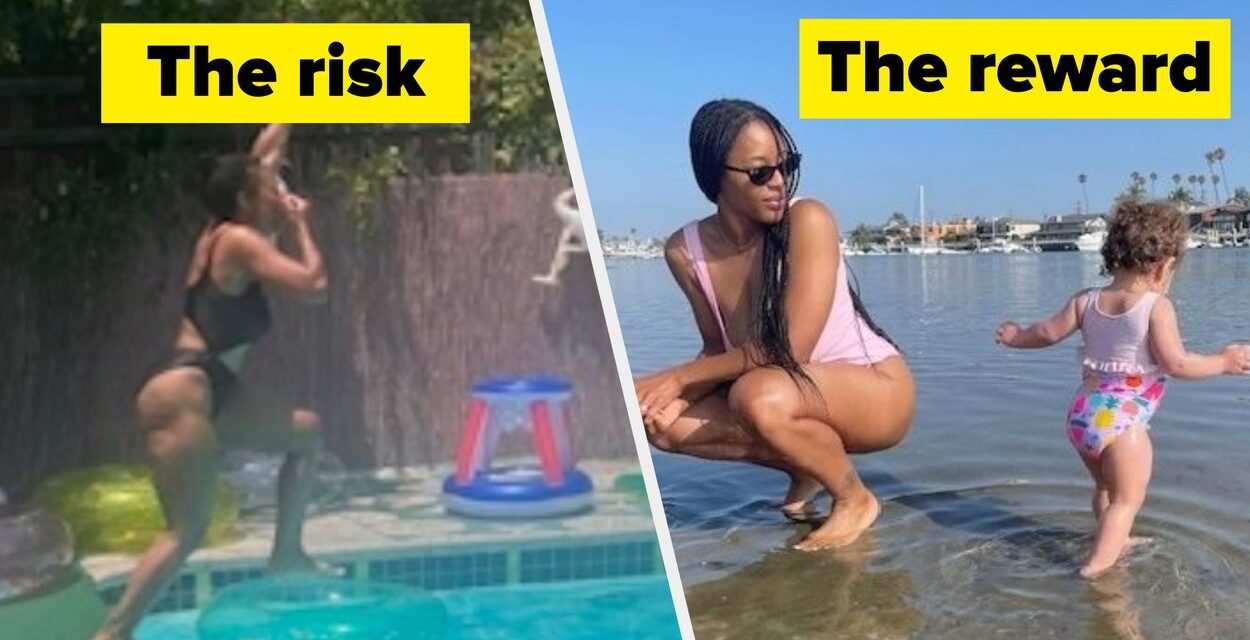
The day I decided to learn how to swim was uneventful. I was at home nursing my then-14-month-old daughter when I came across a video on social media of a mom blogger I follow. In the video, her 2-year-old was jumping fearlessly into a pool as an instructor waited nearby in the water to catch the kid. The kid didn’t need catching. The child popped up to the surface of the water just as fast as he jumped in and stayed afloat by treading. “Wow, I hope my daughter can do that,” I thought. This thought was immediately followed up with, “Wow, I want to do that.”
I was a 38-year-old woman who couldn’t swim.
Over the years, I’ve concocted a lot of reasons for not learning how to swim, but the truth is it was never a priority. I grew up in Chicago where outdoor activities like going to the pool were limited to warm months.
Even then, swimming wasn’t on the list of things to do in the summer for us. Were my friends and classmates and their families going to the pool? Probably, but if so, I didn’t know about it. And taking a dive in often-contaminated Lake Michigan wasn’t a thing.
In high school, Swim 101 was a mandatory course for all freshmen. But, as my luck would have it, the pool was broken my freshman year. To think about it, I don’t remember even seeing the pool my entire four years of high school.
It’s important to note that I’m Black. For most of my life, I fit right into the stereotype that Black people can’t swim. Unfortunately, the stereotype has some truth to it. A national study conducted by USA Swimming (the U.S. governing body for the sport of swimming) and the University of Memphis found that up to 70% of Black/African-American people can’t swim, compared with roughly 31% of Caucasians who can’t swim.
Culturally, I knew that while some of my Black friends did, in fact, know how to swim, a lot of them didn’t. This was in comparison with my white friends,, who all knew how to swim. I wondered what caused such a wide variance in the statistics between the two races and found out that historical systemic racism might be at the helm.
Some say access to swimming pools geographically and economically created barriers for Black communities to produce swimmers. We also can’t forget the racial history of swimming pools. During the era of segregation, Black people were often denied access to public swimming pools and beaches. This exclusion prevented many from learning how to swim and from enjoying aquatic recreation.
Even in areas where Black communities had access to swimming facilities, these pools were often underfunded and poorly maintained, making them less appealing and safe for swimming. The lack of access to swimming facilities for previous generations means that many Black parents and grandparents didn’t learn to swim and thus were less likely to teach their children.
Perhaps the most oversimplified reason I’ve heard as to why we can’t swim is that Black women, in particular, avoid the water sport to protect the delicate texture of our hair and preserve its upkeep. I don’t believe this.
If I’m honest, being a mom played a more significant role in my desire to swim than being Black. Not only did I want to learn how to swim to inspire my daughter to do it, I wanted to be able to jump into a pool without hesitation if she were in trouble and needed saving.
As warmer months came, social media flooded my timeline with ads and popular videos about toddlers drowning from lack of supervision and inexperience in the water. I was paranoid and anxious. And I had reason to be. The National Drowning Prevention Alliance says drowning is the No. 1 killer of kids ages 1 to 4. The only way to minimize my fears would be for me to learn the lifesaving skill.
Finding adult swim lessons in my area was difficult as lessons mostly catered to children. But I eventually landed on the YMCA’s group classes. My first class started off rocky due to me running late for the 30-minute class from trying to find parking. Still, it didn’t stop me from jumping right in.
“Hey, welcome. We’re gliding across the pool,” my instructor said. “What is gliding?” I thought. Quickly,She loves the water and, at 2 years old, is able to take direction and understand the basics of water safety. I caught on by seeing my other classmates ― who were mostly Black and Latina women ― lying flat on their bellies on the water while extending their bodies out straight. Testing this out, I felt intimidated and free all at once.
Once I mastered gliding and floating, I moved on to freestyle, the most basic swim technique. In my experience, and from what instructors have told me, it is much more challenging for adults to learn how to swim than for children. Most adults have developed fear of the water, something that is often absent from fearless kids, and adults also overthink. Again, kids tend to do first, then think later, or at least my toddler does.
My hips sank, I struggled to get air, and I couldn’t for the life of me figure out how to kick from my hips. Synchronizing my body parts to move seamlessly all at once felt unnatural and as if I were learning to walk for the first time. I grew frustrated. But I wasn’t frustrated enough to quit, again.
Ten years prior, I took multiple rounds of swim lessons and walked away without mastering the activity. Childless, young and free, my only goal was to be able to hold a margarita while staying afloat in the deep end of the pool with my friends. Needless to say, this wasn’t a big enough motivator for me to continue lessons and practice on my own.





